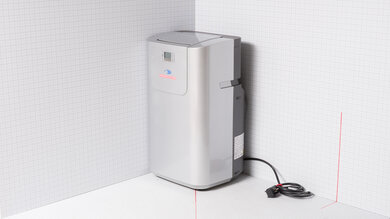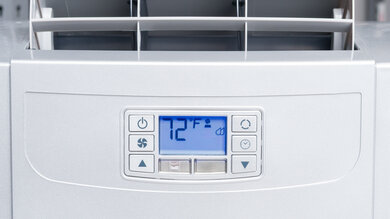The Whynter Elite ARC-122DS is a portable A/C designed for medium-sized rooms, with an advertised capacity of 7,000 BTU/hr and a coverage of 400 ft² (37 m²). It boasts a dual-hose design, separate operating modes for cooling and dehumidifying, and three levels of fan speed. There's also a remote control, but this model doesn't have Wi-Fi connectivity.
Our Verdict
The Whynter Elite ARC-122DS performs adequately in large rooms. Its cooling capacity is on the lower end for bigger living rooms or open-plan areas, and as a result, it'll take quite a while to drop temperatures to a desired level. Despite having a theoretically more efficient dual-hose design versus simpler single-hose portable units, its energy efficiency still pales in comparison to pricier portable units with inverters, or even simple window-mounted A/Cs. On the upside, this unit is pretty quiet while it runs, so it won't be much of a disruption if you have it on while watching TV or listening to music.
-
Low operating noise.
-
Poor efficiency for a dual-hose design.
-
Capacity is limited for larger spaces.
The Whynter Elite ARC-122DS is only a passable choice for smaller spaces like bedrooms. It does a poor job of maintaining the ambient perceived humidity level, which can fluctuate due to compressor cycling. However, this doesn't have much of an impact on the setpoint temperature. Its overall power efficiency is pretty poor, despite its dual-hose design. On the upside, it isn't too big in size and can be squeezed into a larger closet while not in use, though reinstalling its hoses can be a bit of a bear. It also runs pretty quietly, so it won't keep you up if you're trying to get some rest.
-
Will perform adequately well in smaller rooms.
-
Low operating noise.
-
Poor efficiency for a dual-hose design.
-
Poor humidity stability in smaller rooms.
The Whynter Elite ARC-122DS' overall efficiency is pretty bad. Its compressor needs to work hard to maintain a stable temperature even within small- to medium-sized rooms, driving up power demands and decreasing overall efficiency.
-
Poor efficiency for a dual-hose design.
The Whynter Elite ARC-122DS isn't especially flexible for use in a variety of rooms. Since this is a non-inverter unit that cycles off once the desired temperature is reached, ambient humidity levels are liable to shoot back up once this occurs. However, this compressor cycling doesn't have nearly as drastic an impact on the ambient temperature stability.
-
Poor humidity stability in smaller rooms.
The Whynter Elite ARC-122DS is impressively quiet while operating. Even with the compressor engaged and the fan running at its highest level, operating noise is sufficiently low to be mostly masked by a TV at a normal volume. It won't be much of a disturbance if you leave it running overnight.
-
Low operating noise.
- 6.6 Large Room
- 6.4 Bedroom/Small Room
Performance Usages
- 4.5 Combined Efficiency
- 5.1 Oversizing Tolerance
- 8.0 Noise
Changelog
Differences Between Sizes And Variants
You can buy the Whynter Elite ARC-122 with or without a separate heating functionality. We tested the model without the heating function, called the ARC-122DS, while the model with heating is called the ARC-122DHP. For those interested, here's the product label.
Let us know in the comments if you come across another variant of this air conditioner.
Compared To Other Air Conditioners
The Whynter Elite ARC-122DS is a portable A/C unit designed for medium-sized rooms. On the surface, it's a fairly well-rounded machine, with a moderately-sized body for something with this level of capacity, a trio of operating modes, and a dual-hose design that will, in theory, give it an efficiency advantage over single-hose alternatives. Unfortunately, this design doesn't result in much of an efficiency boost or even a significant difference in cooling performance over other single-hose models like the LG LP0721WSR or Black+Decker BPACT12HWT. On the upside, it operates far more quietly than either of those models.
The Whynter Elite ARC-122DS is better than the LG LP0721WSR. The Whynter has a greater overall cooling capacity and won't struggle to the same extent in oversized areas. It also runs far more quietly. It's worth noting that the LG's modest capacity does have a bit of an upside, however, in that its compressor is forced to run almost constantly to achieve your desired temperature instead of cycling on and off, so there are no big swings in ambient humidity or temperature levels.
The Whynter ARC-14S is simply flat-out better than the Whynter Elite ARC-122DS. The ARC-14S does take up a little more room, with a taller, wider body, but its slightly higher capacity mostly pays dividends in most situations. It's faster to cool most rooms, and its compressor isn't stressed as hard when cooling bigger spaces, improving overall energy efficiency. That said, the Elite ARC-122DS does pull ahead in terms of operating noise.
The Black+Decker BPACT12HWT and Whynter Elite ARC-122DS are pretty evenly matched portable A/Cs. While the Whynter has an on-paper edge in cooling capacity and efficiency due to its dual hose design, both models are similarly mediocre in terms of performance. The only area where the Whynter pulls ahead is in its lower operating noise, and even then, it's only by a slim margin.
Test Results
This A/C comes with additional covers for its hose ports for when the unit is stowed away, along with a separate cover for the entire unit that has a built-in pouch for the remote and user manual.
It's worth noting that setting the unit up can be a tedious process: the exhaust tubes take quite a bit of effort to snap onto the body, and they need to be screwed onto the window bracket instead of using a more common easy-snap system.
This model's cooling capacity is okay. While it's adequate for a small room like a bedroom or office, it's on the low end for bigger living rooms or open-plan areas. You can expect it'll take quite a while to drop temperatures to your desired level in larger spaces.
This air conditioner's efficiency while cooling is disappointing. With this being a dual-hose unit, which are far more efficient than single-hose portable A/Cs, we initially anticipated that the Whynter Elite ARC-122DS would perform better in this regard. All the same, it's clear that this unit needs to work very hard to cool small and medium-sized spaces.
The Whynter Elite ARC-122DS has poor temperature maintenance efficiency. Its compressor runs almost constantly to maintain the desired temperature.
The sudden drop and rise in energy consumption is partially due to a workaround for an improperly calibrated thermostat. In testing, the unit would attempt to cool below the desired 21 °C target. To rectify this, we set the thermostat higher, to a target of 22 °C instead. This allowed the A/C to stick closer to our desired target; in doing so, the compressor would cycle off once it had reached 21.1 °C.
The Whynter Elite ARC-122DS does a poor job of maintaining ambient humidity levels. Once the desired temperature level is achieved, the compressor turns off for a relatively prolonged period, leading to a sudden increase in humidity levels. Our own testing environment, which has an approximate volume of 26 m3, slightly exceeds this unit's capacity, leading it to shut off its compressor only once instead of cycling on and off as it would in a properly-sized space.
In a larger space where the A/C unit's capacity is overextended, its compressor would be forced to run almost constantly. This, in turn, would likely prevent the compressor from cycling off and prevent any spikes in humidity, similar to the behavior we observed with the SereneLife SLPAC8.
The Whynter Elite ARC-122DS is pretty basic overall. It has separate modes for cooling, running only its fan, or dehumidifying a room, and it comes with a remote control.
There's also an additional activated carbon filter that you can fit over the washable filter. In theory, this filter is meant to cut down on odors as the unit runs, but it's simply too insubstantial to have much of a real-world impact.



